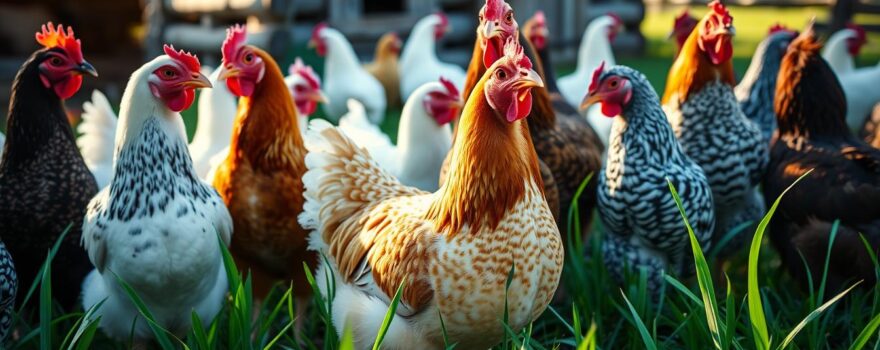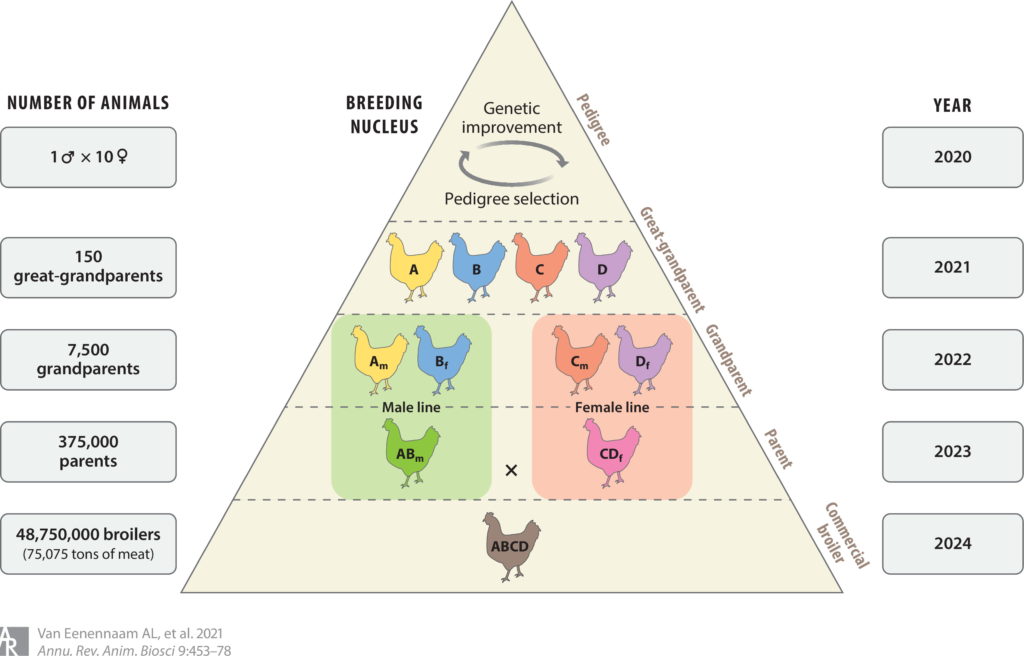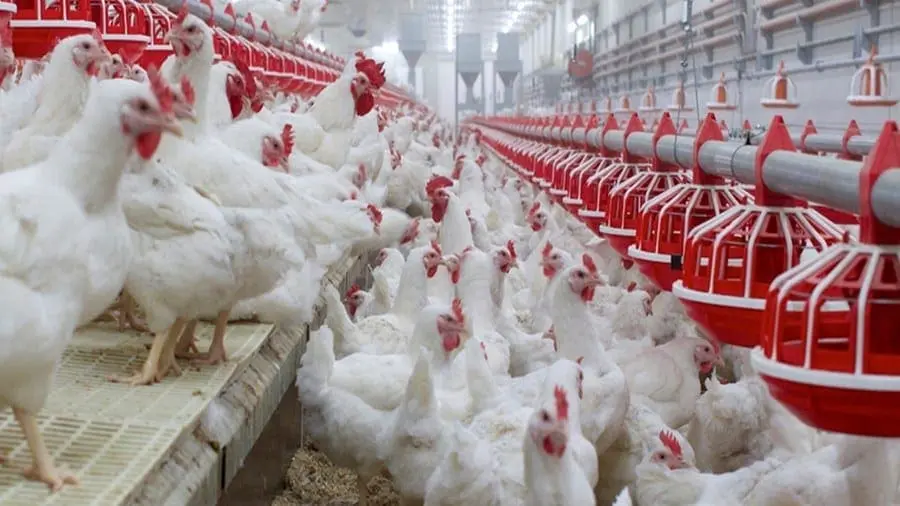
The chicken industry in the United States has changed a lot in the last 100 years. In just over 50 years, it went from small, local farms to a big, efficient industry. Today, it makes healthy, tasty chicken that’s easy on the wallet.
This success comes from better organization, new tech, and listening to what people want. This article looks at the important steps that made the chicken industry what it is today.
Key Takeaways
- The U.S. broiler industry has evolved from fragmented, locally oriented businesses to a highly efficient, vertically integrated, and progressive success story.
- The modern chicken industry produces nutritious, wholesome, and high-quality products that have become more affordable over time.
- Improved production and processing technologies, as well as responsiveness to consumer demands, have contributed to the industry’s success.
- Broiler chickens have undergone significant genetic improvements and selective breeding, leading to enhanced growth rates and feed efficiency.
- The commercialization of broiler production has played a key role in the transformation of the chicken industry.
Early Days of Poultry Farming
In the early 1900s, the U.S. focused on backyard flocks of dual-purpose chickens. These chickens gave both eggs and meat for special meals. But, they didn’t produce all year because people didn’t know about the photoperiod’s role.
Backyard Flocks and Dual-Purpose Chickens
Many homes had small backyard flocks of chickens. They were used for eggs and meat on special days. These dual-purpose chickens were found everywhere, helping families get protein.
Emergence of Selling Young Chickens for Meat
Some farmers started selling young chickens during the summer as a side job. This was the start of a new poultry industry. They saw selling young chickens for meat as a way to make money.
But, seasonal production was still common. This was because people didn’t understand the photoperiod’s importance yet.
“By 1952, specially bred meat chickens (“broilers”) surpassed farm chickens as the number one source of chicken meat in the United States.”
The Birth of the Broiler Chicken
Chicken meat production changed a lot with the broiler chicken. This chicken was raised just for its meat. Places like the Delmarva Peninsula, Georgia, Arkansas, and New England became key areas for raising these birds.
These places had good weather, enough land and water, and easy access to food like corn and soybeans. This made them perfect for raising broiler chickens.
Dedicated Meat Chickens Gain Popularity
In the early 1900s, the broiler industry started to grow. People wanted affordable, tasty meat. Farmers saw the chance to make money by raising these special meat chickens.
They began to focus on breeding and raising these chickens. This was a big change for the poultry industry.
Cecile Steele’s Pioneering Efforts
Cecile Steele from Sussex County, Delaware, was a key player in the broiler industry. In 1923, she got 500 chicks instead of 50. She saw an opportunity and by 1926, she was raising 10,000 meat-type chickens.
“Cecile Long Steele of Sussex County, Delaware, is often cited as the pioneer of the commercial broiler industry.”
Cecile’s creativity and business sense were key in starting the broiler chicken industry. Her work helped it grow a lot in the years that followed.
The Development of Broiler Chickens: Key Milestones in History
The broiler chicken industry has changed a lot in the last 100 years. It started with backyard flocks and dual-purpose chickens. Now, it focuses on raising meat chickens fast and efficiently.
Cecile Steele was a key figure in this change. She pushed for meat chickens that could meet the demand for affordable poultry. This led to the creation of specialized broiler chickens.
Technology and innovation drove the industry forward. Better feed, hatchery operations, and machines changed how chickens were raised. Today, the industry is huge, with billions of chickens raised every year. In the US, people eat more chicken than beef or pork.
| Milestone | Timeline | Impact |
|---|---|---|
| Emergence of specialized broiler chickens | Mid-20th century | Enabled the dedicated production of meat-focused birds, meeting growing demand |
| Advancements in feed formulations and hatchery operations | 1950s-1960s | Improved efficiency and scale of broiler chicken production |
| Mechanization and automation in the industry | 1970s-1980s | Further boosted productivity and reduced labor costs |
| Globalization and international trade | 1990s-2000s | Expanded the broiler chicken market and increased exports |
These milestones have made the broiler chicken industry what it is today. It’s a big and innovative sector that meets the world’s growing demand for poultry. The industry keeps growing, showing how innovation and hard work can lead to success.
Vertical Integration and Technological Advancements
In the early to mid-20th century, the broiler industry saw big changes. Feed mills, hatcheries, farms, and processing facilities started working together more closely. This move towards vertical integration helped the industry use new technologies better. It made the industry more efficient, quick to respond, and more profitable.
Feed Mills and Hatcheries Lead the Way
Feed mills were key, offering credit to farmers for feed and chicks. Soon, entrepreneurs saw the value in combining these steps. This move gave the broiler industry better control over its supply chain. It helped optimize production and distribution.
Mechanization and Automation Boost Efficiency
At the same time, the broiler industry saw a big leap in mechanization and automation. New tech, like automated feeding systems and processing gear, improved efficiency. These advancements made broiler production faster and cheaper, leading to higher yields.
The mix of vertical integration and new tech pushed the broiler industry into a new era. It set the stage for the modern industrial chicken production we see today.
“The broiler industry’s embrace of vertical integration and technological advancements transformed it into a highly efficient and responsive sector, paving the way for the widespread availability and affordability of chicken meat.”
Branding and Marketing Strategies
In the late 1960s and early 1970s, big companies in the broiler industry started using TV and print media to market chickens. Today, 95% of broilers sold in grocery stores have a brand name. This move towards branding and marketing has helped keep customers coming back, ensured quality, and met consumer demand.
The rise of branded chicken products has changed the industry. It lets producers stand out and connect better with customers. By highlighting their brand’s unique qualities, companies can charge more. This focus on branding boosts profits and builds trust and loyalty with shoppers.
| Brand | Market Share | Unique Selling Proposition |
|---|---|---|
| Perdue | 18% | Antibiotic-free, humanely raised |
| Tyson | 21% | Reliable quality, value-driven |
| Foster Farms | 13% | Fresh, locally sourced |
| Pilgrim’s Pride | 16% | Sustainable, environmentally friendly |
The smart use of branding and marketing has made chicken the top protein in the U.S. By keeping their promises, producers have gained loyal customers. This has also led to the rise of private-label products in stores.
“Branding and marketing have been instrumental in transforming the broiler industry, empowering producers to differentiate their offerings and cultivate lasting relationships with consumers.”
Improving Breed Genetics and Production Practices
The broiler chicken industry has seen big changes in the last century. It started as a side product of the egg industry. Now, thanks to the “Chicken-of-Tomorrow” program, it focuses on raising chickens for meat.
Selective Breeding for Desired Traits
Research on broiler genetics grew after Mendelism was rediscovered. This led to breeding programs that focus on meat traits. Poultry experts have worked hard to create chickens with bigger breasts, faster growth, and better feed use.
These genetic changes, along with better production methods, have helped the industry grow. Now, people can easily buy affordable, high-quality chicken.
The broiler industry uses advanced breeding and genetics to provide affordable meat worldwide. Elite breeding programs are set up in different places to fight diseases and adapt to climate and politics.
But, there’s a limit to how much genetics can improve, mainly in body weight. Still, the industry keeps improving through selective breeding and better production. This effort makes sure we have affordable, quality chicken everywhere.

“The broiler industry heavily relies on sophisticated breeding programs, sound genetics, and scientific technology, allowing for the global provision of an affordable meat product.”
Regulatory Changes and Safety Standards
The broiler industry has grown a lot over the years. This growth came from new rules and safety standards. In 1949, the USDA started a program to check the quality of chicken. Then, in 1959, they made it a must to check all broilers.
In 1998, the USDA made a big change. They started using the HACCP system in big chicken slaughter places. This system helps make sure chicken is safe and of good quality.
USDA Grading and Mandatory Inspections
The USDA’s grading program was a big help. It started as a choice but became a must. It helps people know what they’re buying. It looks at things like how the chicken looks and feels.
In 1959, making chicken inspections a must was a big step. It showed the industry’s commitment to keeping food safe. It also protected the people who eat chicken.
HACCP Implementation for Food Safety
The HACCP system changed how chicken is made safe. It uses science to find and stop problems. This makes chicken safer and better for everyone.
By using HACCP, chicken makers have improved their products. This has made people trust chicken more. It’s helped the chicken industry a lot.
| Regulatory Changes | Year Implemented | Impact on Industry |
|---|---|---|
| USDA Grading Program (voluntary) | 1949 | Established quality standards for broiler chickens, allowing consumers to make informed choices. |
| Mandatory Federal Inspection of Broilers | 1959 | Strengthened the industry’s commitment to food safety and consumer protection. |
| HACCP Implementation | 1998 | Introduced a science-based system to identify and control potential food safety hazards, enhancing product quality and consumer confidence. |
These changes have been key for the broiler industry. They help make sure chicken is safe and good for people to eat.
The Rise of Chicken Consumption
In the United States, chicken has become more popular over the years. It now beats out beef and pork in sales. This change is due to better ways to make chicken, new products, and marketing. People also see chicken as a healthier and cheaper choice than other meats.
Surpassing Beef and Pork Consumption
In 1985, chicken overtook pork in sales. By 1992, it also beat out beef. Today, the average American eats about 81 pounds of chicken each year. This is a big jump from before.
Several reasons explain why chicken is now the top choice. These include:
- Improved production efficiency: Better feed, breeding, and processing make chicken cheaper to make. This means lower prices for us.
- Perceived health benefits: Chicken is seen as leaner and healthier than beef and pork. This fits with the trend for nutritious, easy meals.
- Product innovation: The chicken industry has come up with many new products. This makes the chicken more interesting and useful for us.
The U.S. population is growing and getting more health-conscious. This means more people want quick, easy meals. Chicken is likely to stay the top choice for animal protein in the country.
“Worldwide per capita consumption of poultry, mainly chicken, increased by 41% between 2000 and 2016, and OECD forecasts show that poultry will surpass pork as the world’s ‘preferred animal protein’ by 2025.”
Exports and Global Expansion
The broiler industry in the United States grew more efficient and productive. It started to reach out to the world. In the early 1990s, the U.S. sent its first frozen poultry leg quarters to the Soviet Union. They were called “Bush legs” there.
When the Soviet Union broke apart and international markets opened, U.S. poultry exports soared. By 2001, chicken exports made up about 20% of U.S. production. They were worth over $2 billion.
The growth of poultry exports has driven the broiler industry’s global expansion. Countries in South Asia and sub-Saharan Africa want affordable protein. U.S. producers are meeting this demand. This has boosted the industry’s revenue and helped improve nutrition and food security in these areas.
“The broiler industry’s ability to consistently produce high-quality, cost-effective chicken meat has been a game-changer in global exports and expansion.”
But, the industry faces challenges like trade barriers and geopolitical tensions. The recent U.S. and Russia tensions show the need for producers to diversify and stay flexible in their global supply chains.
| Metric | Value |
|---|---|
| Worldwide broiler production in 2005 | 71,851,000 tonnes |
| Broiler industry growth from 1985 to 2005 | 158% |
| Feed conversion ratio (FCR) for broilers in 2018 | 1.5 |
| Greenhouse gas emissions per kg of broiler meat | 6 kg |
| Time to produce a 2 kg chicken in the 1980s | 70 days |
| Time to produce a 2 kg chicken in 2018 | 29 days |

The broiler industry must keep evolving to meet global demands. Exporting and expanding into new markets is key to its success. By using technology, improving supply chains, and forming partnerships, U.S. producers can stay leaders in the global poultry industry.
The Modern Industrial Chicken
The broiler industry has worked hard to make chickens more efficient and profitable. They’ve bred chickens to grow fast and have big breasts. Now, chickens can be ready for market in just 47 days, down from 1920s levels.
These changes have made chicken cheaper and more popular in America. In 2013, people ate over 83 pounds of chicken each, beating out beef and pork. The cost of chicken has also gone up slower than other foods since 1960, making it even more appealing.
But, focusing too much on efficiency has raised worries about chicken welfare. Some breeds face health issues like bone and heart problems. The industry is now looking to offer more variety and meet different market needs while keeping chicken affordable for everyone.